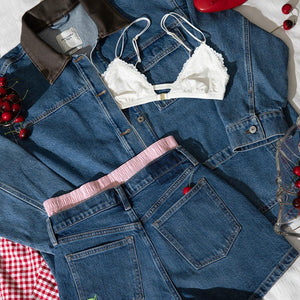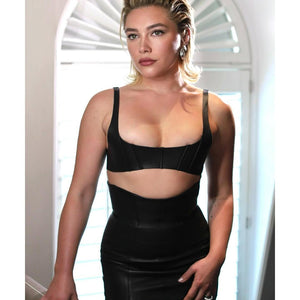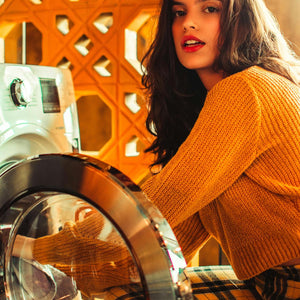
Instagram/@macduggal
The chandeliers glitter in anticipation. The sweeping staircase pulses with the footsteps of a thousand stories waiting to be told. In the grand foyer, an entirely different show has already begun. Sumptuous fabrics sing in jewel tones; daring silhouettes pirouette down the promenade. It's opening night, and the fashion on display is nothing short of art.
How do we define elegance in an era that prizes individuality as much as tradition? For women drawn to the living splendor of theater and opera, this question is more than an aesthetic curiosity — it's a sartorial puzzle begging to be solved with every curtain call. As we navigate shifting dress codes and the allure of making a statement, one thing remains certain: the magic of dressing up is an essential part of the magic on stage.
A Brief History of Women's Formalwear

Leonie could easily wear this outfit for a black tie event. Instagram/@leoniehanne
Before we explore the now, let's set the scene with a bit of history. In the early 20th century, women's formalwear was characterized by long, sweeping gowns with intricate embellishments. The 1920s saw a dramatic shift towards shorter hemlines and more streamlined silhouettes, thanks in part to the influence of fashion icons like Coco Chanel.
Through the decades, women have continued to push the boundaries of black tie. In the 1960s, the little black dress became a formal staple, offering a sleek and sophisticated alternative to the traditional ball gown. The 1980s ushered in an era of bold shoulders and opulent fabrics, while the 1990s saw a return to minimalism with slip dresses and slinky silks.
Now, women's black tie encompasses a range of expressions. At its core, it still denotes a certain level of formality and respect for the occasion. But within those parameters, there's room for playful experimentation. The question on everyone's lips: What does black tie mean for women now?
Decoding the Modern Dress Code

The guests of Save Venice Ball, April, 2025. Instagram/@oscardelarenta
First, let's break down the different categories you might encounter on an event invitation:

Christine Baranski in a white tie attire at the Metropolitan Opera Gala. Note: the outfit might be of any color, not necessarily white. Lexie Moreland/WWD
- White Tie: The most formal option, involving floor-length gowns, often with long gloves and lavish jewelry. Usually reserved for state dinners and the fanciest of galas. Think Bridgerton, but make it couture.

If you need a black tie inspiration, check out Kate Middleton's evening looks. Rex Features
- Black Tie: One step below white tie, but still firmly in the formal camp. Dresses should be floor-length or calf-length (unless the invitation specifies "short black tie"). Fabrics should be rich and luxurious, with elegant details like beading or lace. The standard for a glamorous night out.

Tired of dresses? Replace them with a jumpsuit. Silvia Tcherassi, Moda Operandi
- Creative Black Tie: A more playful twist on black tie that allows for bold colors, unexpected accessories, and fashion-forward touches. Jumpsuits, cocktail dresses, and even dressy separates can work here, as long as the overall look reads as elevated and intentional.

Anna Kendrick wearing bustier top and wide leg pants to the NY screening of "Another Simple Favor". Instagram/@zuhairmuradofficial
- Semiformal: A notch below black tie, semiformal usually means cocktail dresses or chic separates. The perfect choice for a swanky night at the theater.
Of course, these categories can mean slightly different things based on the venue and the crowd. A gala at the Metropolitan Opera might skew more traditional, while an edgy downtown theater may welcome more avant-garde interpretations. When in doubt, err on the side of timeless elegance, but don't be afraid to let the spirit of the event guide your choices.
Sartorial Storytelling: Communicating Through Clothing

Every outfit tells a story. Instagram/@moniquelhuillier
Every time we get dressed, we tell a story about ourselves. This is especially true in formal settings, where the language of clothing takes center stage. A sweeping ball gown suggests romance and drama; a sleek jumpsuit conveys confidence and modernity. Each element of an ensemble is a chapter waiting to be read.
But what happens when the story gets lost in translation? A dress that's too short or too revealing can send an unintended message of disrespect for the occasion. An outfit that's too casual or ill-fitting can undermine the wearer's sophistication. In the world of theater and opera, where tradition reigns supreme, it's important to strike the right balance between personal expression and reverence for the art form.
So how do we communicate elegance and individuality in equal measure? The key lies in understanding the codes — and knowing when and how to break them.
Creativity Within Constraints: Making It Your Own

Instagram/@carolinaherrera
The beauty of formalwear lies in its constraints. By establishing certain rules — the rich fabrics, the sophisticated tailoring, the nods to timeless style — formal dress codes create a framework within which creativity can thrive.
Take the classic evening gown. The floor-length silhouette forms an elegant canvas, but within those parameters, there's endless room for interpretation. A gown with a plunging neckline and a thigh-high slit reads as daring and provocative; a dress with a billowing skirt and a train conjures old-world glamour. Opting for an unexpected color, like a rich jewel tone or a soft pastel, can make a traditional shape feel fresh and modern.
Separates offer another avenue for experimentation. A pair of tailored trousers with a silk blouse and a statement jacket can feel just as "dressed up" as a gown, while offering more flexibility and comfort. The key is to choose luxe fabrics and thoughtful details that elevate the look.

Carolina Herrera, Moda Operandi
And don't forget about jumpsuits! Once considered a daring choice for formal events, jumpsuits have become a chic and modern option for black tie. Look for styles with elegant details like a draped bodice, a belted waist, or flowing, wide-leg trousers.
When accessorizing, choose pieces that complement your outfit without overwhelming it. A pair of chandelier earrings can add drama to a simple gown, while a sleek clutch can punctuate a bold print. Consider finishing touches like a faux fur wrap or an embroidered shawl, which can add texture and interest to your look.
Theater/Opera Outfit Inspiration

Instagram/@sachinandbabi
Now that we've laid the theoretical groundwork, let's explore some outfit ideas for your next theater or opera outing:

Reformation silk gown
- The Timeless Glamour: You can't go wrong with a classic black gown, whether it's a sleek column or a full ballgown. Look for details like tasteful beading, lace overlays, or a subtle train for added drama. Complete the look with a pair of statement earrings and a sleek updo.

Instagram/@gretaconstantine
- The Jewel Tone: Stand out in a sea of black dresses by opting for a rich, saturated hue. A deep emerald green, a regal amethyst, or a burnished copper will turn heads without raising eyebrows. Pair with metallic accessories and a bold lip color.

When it comes to formal events, Old Hollywood is always a great reference. Instagram/@georgeshobeika
- The Vintage Vixen: Channel Old Hollywood glamour with a bias-cut silk gown, opera-length gloves, and a faux fur stole. Look for dresses with intricate art deco beading or luxe velvet fabrics. Add a retro wave to your hair and a swipe of classic red lipstick.

Instagram/@delcoreofficial
- The Modern Minimalist: Make a statement with streamlined simplicity. A tailored jumpsuit, a sculptural sheath dress, or a pair of flowing palazzo pants with a structured top all offer chic alternatives to the traditional gown. Stick to a neutral color palette and add interest with textural fabrics and architectural jewelry.

Instagram/@lidee_woman
- The Romantic Bohemian: Embrace your inner free spirit with a dress in a flowing, ethereal fabric like chiffon or tulle. Look for details like delicate floral embroidery, lace insets, or a softly draped neckline. Pair with tousled waves, a glowing complexion, and a few delicate layered necklaces.
No matter your personal style, the key is to wear your look with confidence. When you feel comfortable and self-assured, you'll project the kind of effortless elegance that is the hallmark of true style.
A Night to Remember

Instagram/@harithand
There's something undeniably magical about dressing up for the theater or opera. It's a chance to step into a world of heightened glamour and artistry, to become a part of the living history that unfolds on stage and off.
As we've seen, the rules of formalwear are not static — they evolve with each generation, reflecting the values and aesthetics of the time. Today, women have the opportunity to write their own sartorial stories, to interpret the codes of black tie through a modern lens.

Instagram/@paolo_sebastian
So the next time you find yourself ascending those velvet-lined steps, take a moment to revel in the fashion on display. Let yourself be inspired by the creativity and self-expression of your fellow theatergoers. And most of all, enjoy the thrill of being a part of the stylish spectacle.
Because when the house lights dim and the curtain rises, you're not just a passive observer — you're a leading player in the grand drama of life, dressed for the part you were born to play.




